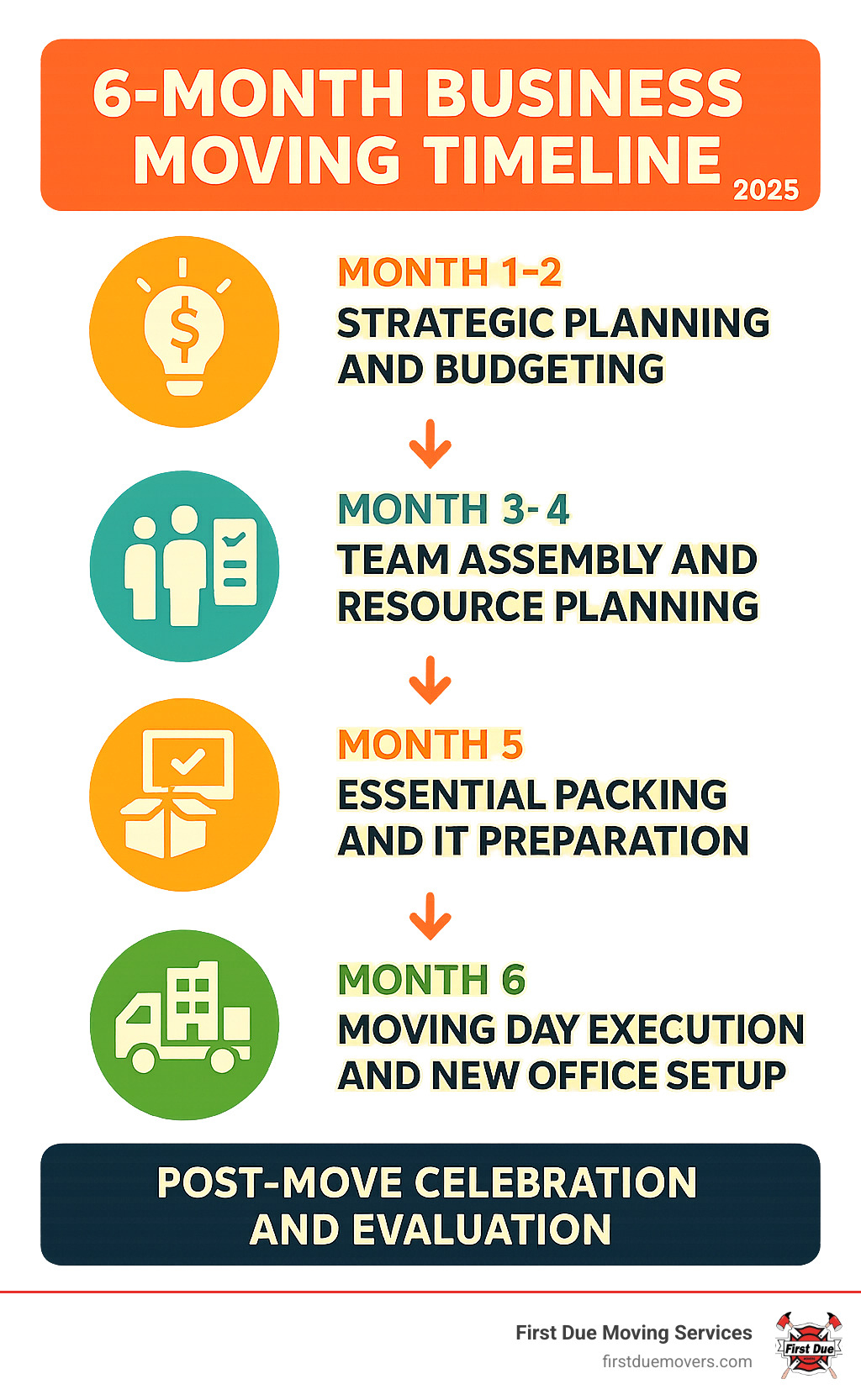Business moving tips: 6-Month Strategic Calm
Why Professional Business moving tips Matter for Your Success
Business moving tips are essential for any organization facing the complex challenge of relocating their operations. Unlike residential moves, business relocations involve a labyrinth of interconnected dependencies, from sensitive IT infrastructure and specialized equipment to maintaining employee morale and client confidence. The critical need to minimize operational downtime is paramount, as every hour of lost productivity directly impacts the bottom line.
Quick Answer: Essential Business Moving Tips
- Start planning 3-6 months early – This extended timeline allows for thorough strategic planning, budgeting, and vendor selection without rushing critical decisions.
- Assign a dedicated move coordinator – A single point of contact prevents miscommunication and ensures all tasks are tracked and completed.
- Hire commercial movers with experience – Professionals understand the nuances of moving businesses, from handling delicate electronics to executing the move with maximum efficiency. Always verify their USDOT number and insurance credentials.
- Create a detailed IT migration plan – Your data and systems are the lifeblood of your company. A meticulous plan for backing up data, migrating servers, and minimizing system downtime is non-negotiable.
- Communicate early and often – Proactive communication keeps employees engaged, assures clients of uninterrupted service, and ensures vendors and suppliers are aligned with your new location and schedule.
- Use a color-coded labeling system – This simple trick dramatically speeds up the unpacking process, allowing departments to get back to work faster in the new space.
- Plan for the unexpected – A contingency fund of 15-20% is a wise investment to cover unforeseen costs like permit delays or last-minute repairs.
- Schedule moves during off-hours – Moving over a weekend or holiday drastically reduces the impact on your daily operations and client-facing activities.
The stakes are incredibly high when moving a business. A poorly executed move can lead to a cascade of problems: lost revenue from extended downtime, damaged equipment, decreased employee productivity and morale, and even lost clients who perceive the transition as unprofessional. According to industry research, transitions can take weeks or months before everything runs smoothly again, and businesses often underestimate production downtime during a move.
The good news? With proper planning and execution, relocating your business can be a strategic opportunity for growth, cost reduction, and improved operations rather than a chaotic disruption. A new location can improve your brand image, improve team collaboration with a better layout, and provide access to a larger talent pool. It’s a chance to reset, declutter, and build a more efficient and inspiring work environment.
This comprehensive playbook breaks down the business relocation process into manageable phases, from initial strategic planning through celebrating your successful move. Whether you’re expanding to accommodate growth, reducing costs, or simply seeking a better location for your team and clients, these proven strategies will help transform your move from chaos to calm.
The Foundation: Strategic Planning & Budgeting (3-6 Months Out)
The most successful business moves start with a solid foundation built months before the first box gets packed. Just like firefighters plan their response strategy before entering a burning building, your business moving tips journey begins with understanding exactly why you’re moving and where you’re headed. This isn’t just about logistics; it’s about strategic foresight.
Starting your planning three to six months ahead isn’t just a nice-to-have—it’s essential for avoiding the chaos that derails so many business relocations. This early planning phase sets the tone for everything that follows, allowing you to negotiate better terms, secure the best vendors, and prepare your team for the change.
Define Your Move’s “Why” and “Where”
Every business has its own story for why it’s time to move. Maybe your team is bursting at the seams and you need more space to grow. Perhaps you’re looking to slash overhead costs with a more affordable location. Or you might be chasing that perfect spot that puts you closer to your best clients while making your employees’ daily commute a breeze.
Getting crystal clear on your “why” makes every other decision easier. When you know you’re moving for growth, you’ll prioritize space and expansion potential. If cost reduction is driving the move, you’ll focus on different factors entirely, such as utility costs and property taxes. If the move is about talent acquisition, you’ll look at proximity to universities and residential areas popular with skilled professionals.
Once you’ve nailed down the why, finding the “where” becomes your next mission. Go beyond a simple map search. Consider these factors:
- Client Accessibility: Can your customers easily find and reach you? Is there ample, convenient parking?
- Employee Commute: Survey your team to understand the impact on their travel time. Consider parking availability and how close you’ll be to public transit options. A difficult commute can lead to decreased morale and employee turnover.
- Local Amenities: What’s in the neighborhood? Proximity to restaurants, coffee shops, and gyms can be a significant perk for your team.
- Zoning and Regulations: Don’t forget to dig into zoning laws early. Nothing derails a move faster than finding your business type isn’t allowed in your dream location. Consult with the local municipality to ensure compliance.
- Future Growth: Smart business owners also think ahead about room for growth—the last thing you want is to outgrow your new space in two years. Does the building or area have options for expansion?
Here’s a pro tip from our firefighter founders: get your team’s input on potential locations. Their buy-in can make or break your transition, and they might spot practical concerns you’ve missed. Check out this helpful Finding the Right Office Location Checklist to make sure you’re covering all the bases.
Create a Realistic Timeline and Budget
Here’s the truth nobody wants to hear: business moves almost always take longer and cost more than you expect. We’ve seen too many companies get burned by unrealistic timelines and shoestring budgets.
The smartest move you can make is assigning a dedicated move coordinator right from the start. This person is more than just a planner; they are the central communication hub. Their responsibilities should include creating the master plan, liaising between departments, coordinating with vendors (movers, IT specialists, contractors), and troubleshooting issues as they arise. Think of them as your move’s incident commander—someone needs to be in charge when things get hectic.
Planning for downtime is crucial. Some businesses think they can flip a switch and be operational immediately in their new space. Reality check: transitions often take weeks or even months to smooth out completely. Consider a staggered move where you keep both locations running briefly, moving departments or inventory gradually to keep disruption to a minimum. This is especially important for customer-facing roles.
When it comes to money, your budget needs to be comprehensive. It must cover way more than just the moving truck. Factor in:
- Real Estate Costs: Deposits, rent, legal fees for lease review.
- Renovation Costs: Painting, flooring, new signage, reconfiguring the layout, electrical work for specialized equipment.
- Professional Services: Movers, IT migration specialists, interior designers, cleaners.
- New Equipment & Furniture: Desks, chairs, or technology upgrades you plan to make.
- Moving Supplies: Boxes, tape, labels, protective wrap.
- Utility Setup: Deposits and installation fees for internet, phones, and other services.
We always recommend building in a contingency fund of about 20% of your total budget for all those little unexpected costs that add up fast—trust us, you’ll probably need it for things like permit fees or last-minute repairs.
These templates can help you stay organized:
To Lease or To Buy? Making the Right Choice
Deciding whether to lease or buy your new space is one of those big decisions that can shape your business for years to come. There’s no universal right answer—it depends on your company’s financial position, long-term goals, and the current real estate market.
| Feature | Leasing | Buying |
|---|---|---|
| Pros | Lower upfront costs, flexibility to relocate, landlord handles maintenance, easier to scale up or down | Building equity, stability, control over modifications, potential tax benefits, no rent increases |
| Cons | No equity building, rent increases, limited control over space, potential lease restrictions | High upfront costs, responsible for all maintenance, less flexibility, market risk, capital is tied up |
Leasing makes sense when you need to preserve working capital for other parts of your business, like R&D, marketing, or hiring. It gives you flexibility if your space needs might change in a few years, and you won’t be on the hook for major repairs or maintenance headaches. It’s often the preferred choice for startups and high-growth companies that need the ability to adapt quickly.
Buying can be the right call if you’re looking for long-term stability and want to build equity instead of paying someone else’s mortgage. You’ll have complete control over how you modify and use the space, but you’ll also be responsible for everything that goes wrong with the building. This path is often better for established businesses with predictable growth and strong cash flow.
The choice often comes down to your business’s financial health, growth trajectory, and how much uncertainty you’re comfortable with. Before making a final decision, consult with a commercial real estate agent to understand market conditions and a financial advisor to analyze the long-term financial implications. Take time to crunch the numbers and think about where you see your company in five to ten years.


